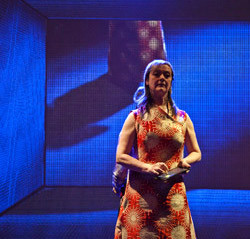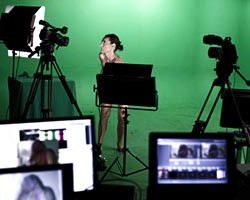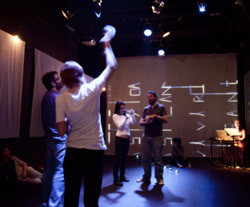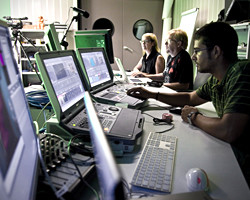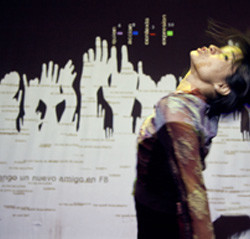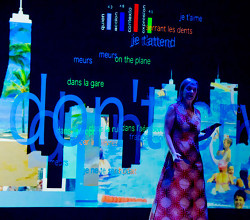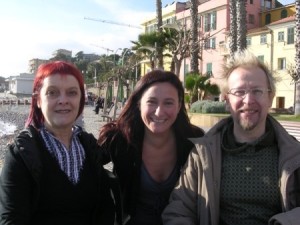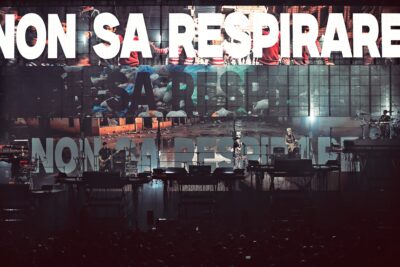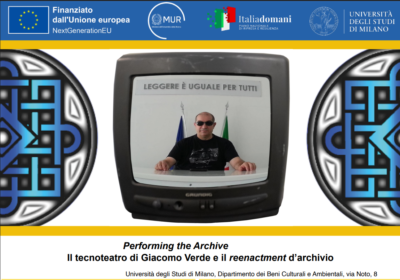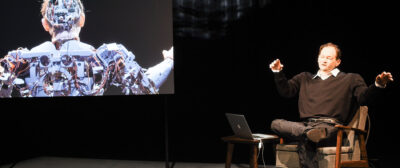Kònic thtr is an artistic platform based in Barcelona dedicated to contemporary creation at the confluence between arts, new technologies and science. The main activity beeing focused on the application of interactive technologies to artistic projects. Rosa Sánchez & Alain Baumann are generating the conceptual, creative and technological ideas in Konic Thtr. Since 1990 they co-direct the activities of that artistic platform and by their projects they promote the meeting and collaboration between artists, theoreticians and technologists of varied disciplines and countries, who are invited to share their creative and research proposals. Rosa Sánchez. Multidisciplinary and multimedia artist, performer & choreographer. Artistic director and co founder of Konic thtr. Alain Baumann. Musician, multimedia artist and researcher of new systems for producing sound. He is in charge of the interactive systems used by Konic thtr. Both have and extensive knowledge and experience of working with new technologies applied to performance, dance, installation and theatre.
Konic is specialized in interactive theater with the use of sensors and in recent years your poetry is almost entirely devoted to the so-called network theater or telematic performance. For a long time the artists have tried to concretize the utopia of connecting minds and bodies at a distance. What is your definition of that and your goal as theater artists and not only as a digital artists?
Connecting minds and bodies at a distance is not a utopia anymore. Maybe it does not take place as we were used to imagine when we were watching science fiction movies, but the connection definitely exists. The whole planet is now covered by a transparent but very active layer of connection between people from different cultures, ideas and ways of perceiving life. As performers and theatre artists, we have always been interested in bringing the ‘outside’ to the theatre, and show the way in which our society is evolving, very closely linked to the way the available technology is evolving. We are interested in the concept of distributed event, networked, as it combines the concept of Telematics with that of network, particular of the digital media
As theatre and performance artists we are always attracted by the exploration of new experiences with the audience. When we started to be interested by telematic works, one of the things that attracted us was the way the piece is experienced by the performers and by the audience. In this type of work, there is a different concept of what the show is and how the audience can perceive it. The stage is spread across countries and sometimes distributed on the Internet, and the audience is attending the show in the different countries where the event takes place. The audience assisting locally in each node will see a different setting on stage, combined with the information received from the other performers and countries. The audience at each location can therefore have a completely different perception of the same piece. This is something that is quite interesting, and although it might also happen in a theatre show in which different members of the audience can see and live a different experience of the same show, in the case of telematics there is always a part (the other part) that can only be seen as a visual and sonic representation.
Your shows (Before the beep, Cuerpo sms) have to do with the mediated image of the person, through thousands of devices and media that speak of us, photographs, social networks, and have to do with his relationship with the media and how they can create or deform personality.Is it a general media critic towards overall social excessive use of media?
In Before the Beep we wanted to explore how our cultural context, highly mediatized, constructs and determines our behaviour and the way in which we communicate. The use of social networks, Internet and the apps we have installed on our inseparable mobile devices are creating new communication codes, and establish new, more playful, social relations. The society has become more proactive and we take this into account when we invite the audience to participate actively during the show. Ask them for instance, by sending phrases through their mobile phone, to bring the semantics of a situation that the actors have to follow. In Before the Beep, we are not really making a criticism about the excessive mediation of our society as much as asking ourselves – and the audience – where can we situate the membrane that separates the private space from the public space on the Internet. A Connected Room of my Own (El Cuarto Propio Conectado) from author Remedios Zafra was a source of inspiration for this piece. In Before the Beep, we also ironize on some situations brought by that intensive use of communication devices, as for example one performer is calling by phone the other performer on stage at sight, something which we experience everyday when people are meeting in crowded areas and cannot see each other even though they are a few feet from each other.
Could you explain exactly how does a network performance work? how one could connect, or partecipate actively and what kind of interactivity do you create? In addition, connected with this, what kind of thematic and dramaturgy (visual, aural) did you created with these specific media?
One of the particularity of network performances is that since they are based on internet networks, they are built on the paradigm of nodes. In theory there could be as many nodes as one wishes. The practice is a bit different, and is technologically complex. Most of the projects we have developed were made possible thanks to a strong technological support and high-speed networks. This is how we can share images between one end of the world and another with good image and sound quality and nearly without delay in the transmission. We have made one piece ‘Arts en Viu en las Llars’ (Live arts from your home) that connected many nodes in which we invited 20 people to take part to a kind of ‘social dance party’ from the comfort of their homes. It was a fantastic project; these people which we did not know at all were suddenly taking an active part in the piece, dancing in front of their webcams. The result of the piece was specifically for the Internet and the visual dramaturgy was based on the creation of visual spaces in which a dancer from our company and the people participating from their home were dancing together.
These projects are highly collaborative, and the dramaturgy that is created depends on how we work with the other partners. Most of the times it is a dramaturgy based on the body, and the choreographed images of the bodies. On the encounter between the remote bodies. The result is usually abstract, and is very much composed live, recreating a virtual space where all the performers intercommunicate, projected on stage and in dialog with the live performers.
The central idea is that one of presence. ..Dance is your language on the scene. How can you manage a dance, a coreography at a distance, using images of distant bodies?
This is exactly the key. We are working with the images of distant bodies and with the bodies present on stage, fed back as images to the other nodes. It is somehow like creating a live videodance. The choreography is not between real bodies, but between their visual (and sometime sonic) representation and the way the cameras capture them. At the same time, there is always a presence, and it is quite easy to loose the sense of what is real and what is virtual, when we have the representation (filmed) of the actual space, superimposed or juxtapose with the images from the ‘other’ space. The shift between the actual and the virtual becomes seamless and it makes the image coming from the other side become a body that is also ‘present’. In our more recent pieces we also start to explore the virtual encounter. In this case, the dancers share on unique virtual three dimensional space, rather than video, and they are represented by digital graphical or sound elements in this space. The information we receive from the dancer is that of their movement in ‘their’ space, and we reconstruct a virtual space in which they all appear together, creating a common virtual choreography. This is something that we are keen to explore in relation with the concept of (tele)presence.
To carry out projects so complex, with rich technology and with a need for fast connection, you needed telematic nodes but also human connections with various artistic groups and cultural spaces in the world. How have you made this network of partnerships given that there are very few artists who are dedicated to this aspect of the theater?
Since we started to work with technology in the early Nineties, we have developed a work praxis in which we generally involve many different partners. Collaborating with technological specialists, but also universities as research partners that can help us to find ways to develop new tools. Since the year 2000, a strong interest from technological experts working in the field of research in high-speed communication technologies has been to open their field of work to the humanities and cultural fields. This means that there are now spaces more or less all around the world where there will be the right people with similar interests. The difficulty is to connect all the elements – the artistic team, the high-speed Internet technologist, and the space to which this high speed connection arrives (most of the time universities). These are new fields to be explored by both artists and technologists and good collaboration is possible while mutual interest exists. Live arts are challenging to networks, as they rely on the interaction between the performers, and the real-time interaction between remote spaces and with high quality audio and video is still a challenge, even for advanced networks. This means that there can be some symbiosis between the artists and the technologists in this case.
Do you consider your art as a politic theater?
To some extend, yes. There are rarely any direct political slogans in our pieces but our proposals are developed with the intention to trigger reflexion in the viewers. Our proposals are usually intended to be destabilizing, hence critical with the dominant system.
Which is the effects on the audience to this new type of performance?
It is quite clear that there is a growing interest of people to access cultural offer via the Internet. Streaming is for us a part of the pieces that we do in this field of telematics. We compose it as an autonomous piece, of videodance or videocreation, which is forming part of the whole work. We detect a growing interest in this type of proposals. On one hand, the audience assisting in the theatre is enthusiastic to see performers that are acting from a remote location with the local performers. On the other hand, there is a part of the audience that experiences the event from the Internet, viewing the piece live as streaming.
The effect on the audience depends on how you show the work, on how open the audience is to come and see something that is unconventional and it also sometimes depends on their age. In Kònic we like to make pieces that are unconventional, and so the audience who come to see us has to connect with the unconventional (whatever this might mean). That said, the audience does not necessarily have to see this as a new type of performance, it is just not conventional, but we still have the intention to transmit emotions and create a live event in the same way as any other theatre piece or live event. In the case of telematics, the audience has sometimes asked us to communicate with the other node, just as if they wanted to make sure that it was real!
Some years ago there was an authentic euphoria for the possibilities of the theatre to create with media a collective piece-performance: there are some examples of net drama, using chat rooms, and some experimentation of mixing video scenography from external of theatre by webcam and texts. But it finished into few years without creating nothing real special and unforgettable. Now some groups are devoted to this aspect like you, I quote Rimini Protokoll. DO you think that this genre, could renewal the contemporary theatre?
The net dramas and other similar experiments were a great way to explore the possibilities of the Internet for rizhomatic creation, but maybe at that time nor the audience nor the technology was ready for a satisfying experience of the work (which would be a first step to make them unforgettable). Since the beginning of theatre, technological advances made the apparition of new artistic genres possible. The work of Rimini Protokoll or of Kònic Thtr would not be possible without the new communication and interaction spaces offered by the Internet or social networks.
There are many people out there creating very interesting works, and the technological changes are making it easier for the audience to be connected to new proposals. We are very interested in pieces that are using the media in a somehow transgressive form, rather trying to reproduce a new version of the old, and this is in our opinion a key to renewal. As well as creating new trends, the way in which contemporary theatre pieces are developed is marked by the way the society apprehends these new communication spaces. These new genres can reach audiences that conventional theatre cannot reach, and it will also open new spaces for artistic expression. An example that comes to mind are the Flash Mobs for instance, and how this type of intervention has become widespread very quickly thanks to the social networks
Do you think to use videomapping for future shows, considering your important experience in this tecnique?
Right now we are very interested in exploring the great possibilities of Video Mapping onto architectural elements but also on stage. We are partner of the European project IAM, a project that was initiated by a group of people in Italy, who are specialists in video mapping, technical experts such as Enzo Gentile and Anughea Studio and media-art history expert like you. The project is proposing the use of Video Mapping for enhancing cultural heritage and this means that we are immersed in the exploration of this technique. Videomapping offers incredible possibilities for live performances, especially for showing work in large scales and on architectural elements, but it also has great possibilities in theatre. We are now preparing a piece to be premiered at the end of 2014 that is based on architectural VideoMapping.
Could you tell something about the IAM experience and your important role for the internationals projects?
IAM is a great project that combines technology and culture. We are really pleased to be part of this project in which different pilot projects are being developed around the same concept: enhancing cultural and natural heritage through Augmented Reality, Video Mapping and other technological tools. In this project we are involved in coordinating a series of festivals that will happen every year around this theme. We want it to be a festive event in which technologist and heritage specialists can meet and find affinities. It is a great experience for us, and of course there will be Video Mapping!


